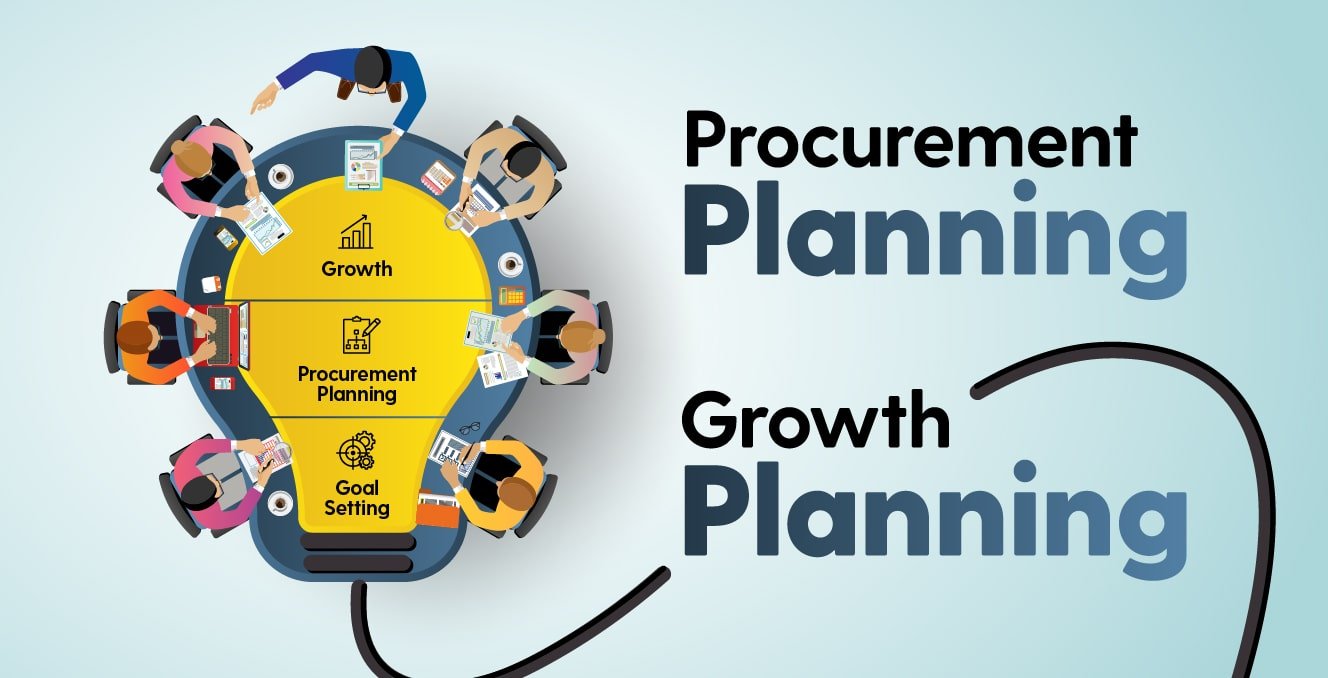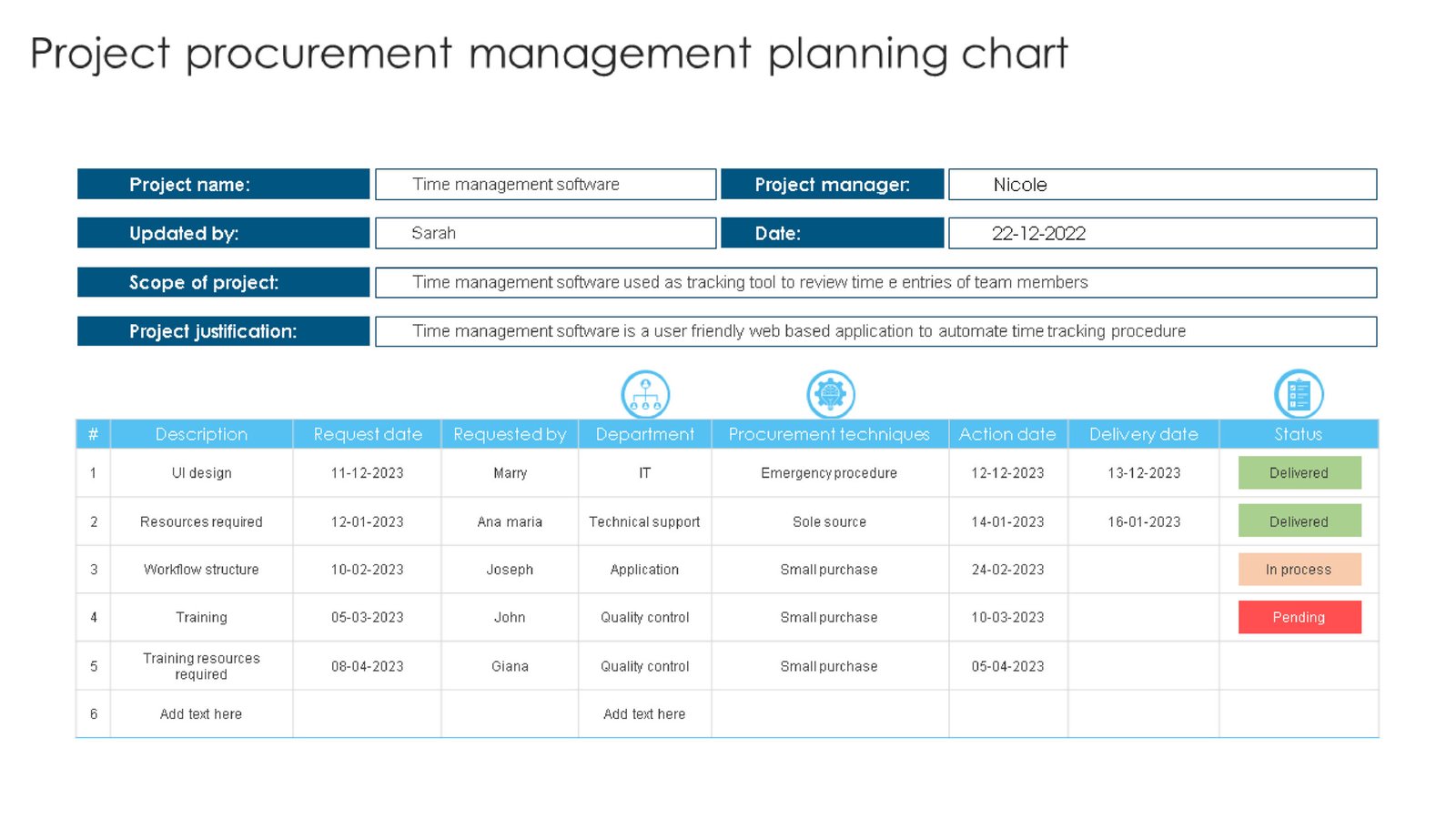Project Procurement refers to the process of sourcing and acquiring the necessary resources from external suppliers to complete a project. These resources can include materials, services, or subcontracted work. The procurement process involves identifying needs, selecting suppliers, negotiating contracts, and managing supplier relationships. Effective procurement ensures that the project receives quality resources at the best possible cost and within the required timeframe.
Importance of a Procurement Plan in Project Management
A procurement plan serves as a roadmap for acquiring the goods and services needed for a project. It outlines the procurement strategy, identifies potential suppliers, specifies procurement methods, and sets the criteria for selecting vendors. By providing a structured approach to procurement, the plan helps project managers and teams manage risks, control costs, and ensure timely delivery of resources.
Related Article: Advanced Project Plan Template Excel Download- PMITOOLS

Key aspects of a project procurement plan include:
- Needs Identification: Determining what goods and services are required.
- Market Analysis: Researching potential suppliers and market conditions.
- Procurement Strategy: Deciding on the procurement methods and strategies.
- Supplier Selection: Establishing criteria for vendor selection.
- Contract Management: Outlining terms, conditions, and contract management processes.
- Risk Management: Identifying and mitigating procurement-related risks.
- Procurement Schedule: Developing timelines for procurement activities.
- Cost Management: Budgeting for procurement expenses and tracking costs.
Related Article: 10 Tips For Creating Project Schedule Template Excel – Download (pmitools.net)
Components of Project Procurement Plan Templates
Effective Project Procurement Plan Templates include several sections that guide project managers through the procurement process. Below, we discuss each section in detail:
- Project Overview: This section provides a brief description of the project, its objectives, and scope. It sets the context for the procurement activities and links them to the overall project goals.
- Procurement Objectives: Here, the specific objectives of the procurement process are outlined. Objectives might include acquiring high-quality materials, reducing costs, ensuring timely delivery, and establishing strong supplier relationships.
- Needs Assessment: This section identifies the goods, services, or works required for the project. It includes a detailed list of items, their specifications, quantities, and the expected delivery schedule.
- Market Research: Effective procurement requires an understanding of the market conditions and potential suppliers. This section involves researching suppliers, market trends, pricing, and availability of required resources.
- Procurement Strategy: The procurement strategy outlines the approach to acquiring the needed resources. It includes decisions on whether to buy or lease, the type of contracts to use, and the procurement methods (e.g., competitive bidding, direct purchase, or partnerships).
Related Article: 10+ Tips For Designing Action Plan Template – PMITOOLS
- Supplier Selection Criteria: This section specifies the criteria for selecting suppliers. Criteria might include price, quality, delivery time, past performance, and the ability to meet the project’s requirements.
- Procurement Schedule: The schedule outlines the timeline for procurement activities, including key milestones and deadlines. It ensures that procurement aligns with the project timeline and that resources are available when needed.
- Budget and Cost Management: This section details the budget allocated for procurement and how costs will be managed. It includes cost estimates for each item, budget tracking mechanisms, and cost control measures.
- Contract Management: Contract management involves developing, negotiating, and managing contracts with suppliers. This section outlines the contract terms, conditions, and processes for monitoring contract performance and handling changes or disputes.
- Risk Management: Identifying potential risks related to procurement and developing mitigation strategies is crucial. This section addresses risks such as supplier failure, cost overruns, and delays, and outlines contingency plans.
- Communication Plan: Effective communication with suppliers and stakeholders is vital for successful procurement. This section outlines the communication channels, frequency, and methods for sharing procurement information.
- Performance Metrics: Establishing metrics to evaluate the procurement process and supplier performance ensures continuous improvement. Metrics might include on-time delivery rates, cost savings, quality of goods and services, and supplier responsiveness.
Role of a Procurement Plan in Project Management
A well-crafted procurement plan plays a vital role in project management by:
- Enhancing Efficiency: By providing a clear roadmap, the procurement plan helps streamline procurement activities, reducing delays and ensuring resources are available when needed.
- Improving Cost Control: Detailed cost management and budget tracking mechanisms help control procurement expenses, ensuring the project stays within budget.
- Mitigating Risks: Identifying potential risks and developing mitigation strategies in advance helps prevent disruptions and ensures smooth project execution.
- Ensuring Quality: By establishing clear criteria for supplier selection and performance evaluation, the procurement plan helps ensure that high-quality resources are acquired.
- Facilitating Communication: A structured communication plan ensures effective information flow between the project team, suppliers, and stakeholders, fostering collaboration and transparency.
- Supporting Decision-Making: The procurement plan provides valuable insights and data, aiding project managers in making informed decisions related to procurement activities.
Related Article: 8 Tips For Designing Product Roadmap Template – PMITOOLS
Developing an Effective Project Procurement Plan Template
- Define Project Requirements: Start by clearly defining the project’s scope, objectives, and requirements. This provides a foundation for identifying procurement needs.
- Conduct Market Research: Research potential suppliers, market conditions, and pricing to gather the necessary information for informed decision-making.
- Develop Procurement Strategies: Based on the project requirements and market research, develop appropriate procurement strategies, including the methods and types of contracts to use.
- Establish Supplier Selection Criteria: Define the criteria for evaluating and selecting suppliers, ensuring they align with the project’s objectives and requirements.
- Create a Procurement Schedule: Develop a timeline for procurement activities, ensuring they align with the overall project schedule and milestones.
- Budget and Cost Management: Estimate the costs for each procurement item and develop mechanisms for tracking and controlling expenses.
- Outline Contract Management Processes: Define the processes for developing, negotiating, and managing contracts with suppliers, including monitoring performance and handling changes.
- Identify Risks and Mitigation Strategies: Identify potential procurement-related risks and develop strategies to mitigate them, ensuring minimal impact on the project.
- Develop a Communication Plan: Establish a communication plan that outlines how information will be shared between the project team, suppliers, and stakeholders.
- Establish Performance Metrics: Define metrics to evaluate the procurement process and supplier performance, ensuring continuous improvement and accountability.
Related Article: 9 Tips To Create A Status Update Email Template – PMITOOLS

Top 3 Project Procurement Plan Templates:
When planning a project, having an effective procurement plan is crucial. Here are the top three templates:
- Creately’s Procurement Management Plan Template: This template helps streamline procurement processes by including project details, procurement design and processes, and contract types. It ensures clear communication, risk management, and cost control, making it ideal for managing complex procurement activities.
- Project Management Docs’ Procurement Plan Template: This free template provides detailed sections for procurement risk management, cost determination, and standardized procurement documentation. It helps manage procurement-related risks, control costs, and maintain standardized documentation across projects.
- ClickUp’s Procurement Project Plan Template: Designed for various industries, this template offers custom statuses, fields, and multiple views (Doc, Board, and List). It promotes collaboration, tracks progress, and integrates with other tools to enhance efficiency and organization in procurement processes.
Related Article: Procurement – Wikipedia
Conclusion
Project Procurement Plan Templates serve as an essential tool in project management, providing a structured approach to acquiring the necessary resources for successful project completion.


